Reaching to the top of Mount Everest is the dream of every mountaineer and also adventure lovers. Known as one of the world-class trekking destinations, the journey to the Everest base camp trek takes you to the legendary foothills, diverse trails with magnificent views of mountains in the Everest region. If you are planning for an adventurous trip to Nepal, the Everest base camp trek is the ultimate thing for you.
Table Of Contents:
- How Long Does it Take to Climb Mount Everest
- Everest Base Camp Trek Cost
- Everest Base Camp Weather
- Everest Base Camp Trek Packing List
- Everest Base Camp Trek Difficulty
- Everest Base Camp Map
- Side Treks of Everest Base Camp
- Everest Expedition
- Everest Trail Walker
The Mount Everest trek route lies in the Khumbu region of Nepal. This region, full of natural and cultural beauty, is also known as the land of Himalayas. The magnificent view of the Everest massif for the Everest base camp is something that you’ll never forget. During your Everest base camp trek, you’ll be able to experience majestic mountain views, encounter the life of the world famous mountain climbers (the Sherpas), walk through the Sagarmatha National Park and visit few of the high altitude Buddhist monasteries.
The iconic Everest base camp trek starts from Lukla. If you have limited stay in Nepal, you can take a direct flight to Lukla from Kathmandu. Recognized as one of the deadliest airports in the world, your flight to the Lukla airport treats you with beautiful views of the Himalayan ranges. The distance from Lukla airport to the Everest base camp is 130 kms to and fro. The Everest base camp trek takes you through the footsteps of Edmund Hillary, Tenzing Norgay and other mountaineers who have summited Everest.
There are two routes that takes you to the Everest base camp. These two routes are known as the South Base Camp and the North Base Camp. The trek to Everest base camp through the south base camp is preferred by most of the trekkers as it starts from Lukla airport. The Everest base camp trek starting from Lukla airport takes you towards Namche Bazaar, which is at an altitude of 3440 meters. Namche Bazar is known to be the heart of the Everest base camp region. Usually, it takes about two days to reach Namche Bazar from the Lukla airport. Namche Bazar is also a point for acclimatization as you’ll be moving towards higher altitude from this region. Most of the trekking itinerary includes a day for rest at Namche Bazar for acclimatization. Trekking from Namche Bazaar takes you to Dingboche 4,260 meters where the trekkers will rest for another day for further acclimatization.
Another route for Everest base camp trek, the North base camp, starts from Tibet, China. To use this route for your Mount Everest base camp trek, trekkers need to obtain a permit from the Government from China and Tibet. Trekkers can obtain these permits from the travel agencies in Lhasa along with vehicle, driver and guide. The North Base Camp is accessed by vehicle through a 100 km road branching to the South from the Friendship Highway near Shelkar. Also, if you have properly acclimatized, you can opt to trek up from the tourist camp. The “tourist Base Camp” is located about halfway between Rongbuk Monastery; the actual climbers’ Base Camp is at the foot of Rongbuk glacier.
Some of the major highlights of the Mount Everest Base Camp trek includes the visit to the renowned Himalayan town of Namche Bazaar, also known as the Gateway to Everest. From this point, you can get beautiful views of Nepali Himalayas like the Thamserku, the Kongdi RI, the Ama Dablam, Lhotse Himal, the Nuptse Peak, and the Kusum Kanguru and of course- Mount Everest. Namche Bazaar is popular with trekkers in the Khumbu region, especially for altitude acclimatization, and is the gateway to the high Himalaya. The town has a number of lodgings and stores catering to the needs of visitors as well as a number of internet cafés. There are German bakeries, little cafes, and many restaurants.
In addition, if you are not a trek lover but want to enjoy the beauty of the Mt. Everest base camp, you can go for Everest base camp tour via Mountain Flight Tour or Heli Tour. These tours takes you very close to the Everest and allows you to fly parallel to the Himalayas enjoying the scenic beauty of the Everest region. Both these options for Mt. Everest base camp tour takes you very close to the Everest region from where you can get a very close view to the beautiful mountains like Mount Nuptse, Mount Lhotse, Machhapuchhre, Ama Dablam, Gaurishankar, and many others along with the Mount Everest. Also, you can also get the view of Gokyo valley, Gokyo lages and the Khumbu Glacier.
The only differences between Mountain flight tour and Heli tour are the total time duration, landing at EBC and Kala Patthar, having breakfast at an extreme height i.e. at Everest View Hotel including some relaxation time. You can enjoy this if you take a Heli tour to the Everest Base Camp. The best part of Mount Everest base camp tour through helicopter is that, it lands in 4 places; Lukla airport, Pheriche, Kalapatthar and Everest View Hotel. Pheriche is a village in Khumbu region situated in an altitude of 4,371 meters where the group of 5 people initially getting into the helicopter splits into two groups and ride separately to get to Kalapatthar.
How Long Does it Take to Climb Mount Everest
How long does it take to climb Mount Everest is one of the most frequently asked questions by the trekkers while planning for their Everest base camp trek. Let us inform you that the Everest Base Camp trek itinerary is usually composed of 14 days. However, if you have limited time, you can also plan for 10 days trek. The 10 days itinerary is recommended for the ones who lack time and prefer not to camp. Also, the amount of time required depends on your body’s need to adapt to and adjust in high altitudes. It is very important to go through the process of acclimatization to minimize the risks and gravity high altitude sickness can present.
Altitude sickness is one of the most common risks, but this can be mitigated following proper Base Camp itinerary. Everest base camp trek is actually listed as one with the highest rates of high altitude sickness. Regardless of your fitness level or how experienced you are in high-altitude mountaineering, following the recommended itinerary could prevent this. While deciding on how many days to climb Everest, you need to keep these things in consideration. No matter how many days you plan for the trek, you’ll obviously get to experience the beauty of the Everest region.
Everest Base Camp Trek Cost
Cost is the major factor for any type of holiday, may it be vacation or trekking. While determining the Everest base camp trek cost, it is very important to consider various factors associated with the cost. We at Happy Holiday Treks & Expedition provide customized Everest base camp trek packages depending on your budget and time availability.
Your Everest base camp trek cost depends mainly on how many days you want to trek for. The Mt. Everest base camp trek is usually for 12-16 days. Another factor to be considered is the time of the year you are planning your Everest base camp trek. As expected, the peak seasons are more expensive compared to off seasons. Your Everest base camp trek also varies according to the medium you buy your package, i.e travel agent, online agent, local guide, etc. Also, the type of package you choose also determines your trek cost. The package can be all inclusive, guide only or independent.
Apart from this, you need to pay for various permits to trek in the Everest region. You need to have TIMS card and a Sagarmatha National Park Permit. The Sagarmatha National Park permit costs $33(Nrs 3,390). With this permit, you can enter Khumbu region as well.
While the price of TIMS card varies according to its type:
Organized TIMS card: $20
Individual TIMS card: $20
SAARC country TIMS card: $10
You don’t need TIMS card for trekking in Everest Region. You can buy a local permit for $20 in Everest Region.
Everest Base Camp Weather
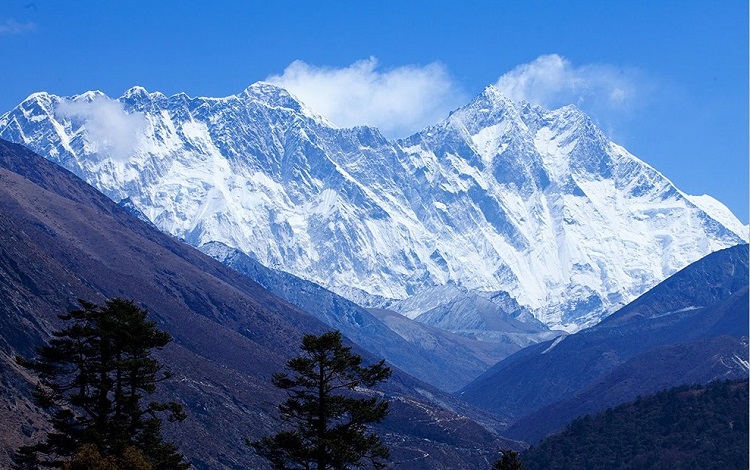
If you are trekking to the Everest base camp for the first time, you need to have enough information regarding the Everest base camp weather. If you look at the trend of the Everest Base Camp weather, you’ll see that different seasons give you different experience at the Everest base camp.
It is always recommended to research on basic information about the weather in that area in order to determine the best time for Everest base camp trek. This way, you can prepare yourself for any type of situation and pack your backpack and clothing according to the weather condition of that area. Usually, the weather condition is really unpredictable at higher altitude, especially in the mountains. Once it’s sunny and the next thing you know, you are running to a shelter; snowfall or blizzards. You’ll encounter drastic weather changes in the higher altitudes.
In Nepal, there are 4 seasons. Spring, Summer, Autumn and Winter season. Please note that the Everest Base Camp weather differs in every season. Snow-capped mountain region is usually never hot, not even in summer. During the day the temperature reaches up to 25 degrees Celsius, maximum and at the night time it may lower down to – 20-degree centigrade or lower on the same day. Despite the low temperatures, the biggest issue faced by climbers are hurricane force winds and wind chill. The region encounters very minimum rainfall, only about 18 inches rainfall is received at the base camp even in rainy season.
Autumn and spring seasons are considered to be the best season for Everest Base Camp trek. The ideal weather with an amazing view of the mountains in this time of the year makes these two seasons the best. October is considered as the best time for Everest base camp trek.
Do research more on the best time for Everest base camp trek and do not hesitate to contact Happy Holiday Treks & Expedition if you have any queries or want any information regarding the best time to trek Everest base camp.
Everest Base Camp Trek Packing List
Trekking at high altitude requires proper packing that includes all the essentials. You need to consider many things while writing your Everest base camp trek packing list. Everest Trail Walker has come up with a packing guideline that will help you pack for Everest Base Camp trek. The Everest base camp trek takes you to an altitude of 5380m which is a very high altitude, presenting you with varying weather conditions. So, what all should be included in your backpacks List for Everest Base Camp Trek.
Packing wisely plays a major role in making the trek less difficult. So, it is very important to pack the right gear and clothing to make your trekking experience smooth and comfortable.
Backpacks List for Everest Base Camp Trek
Now that you are familiar with the climatic condition in the Everest base camp trek, let us take a look at the Backpacks List for Everest Base Camp Trek:
Clothing List for Everest Base Camp Trek
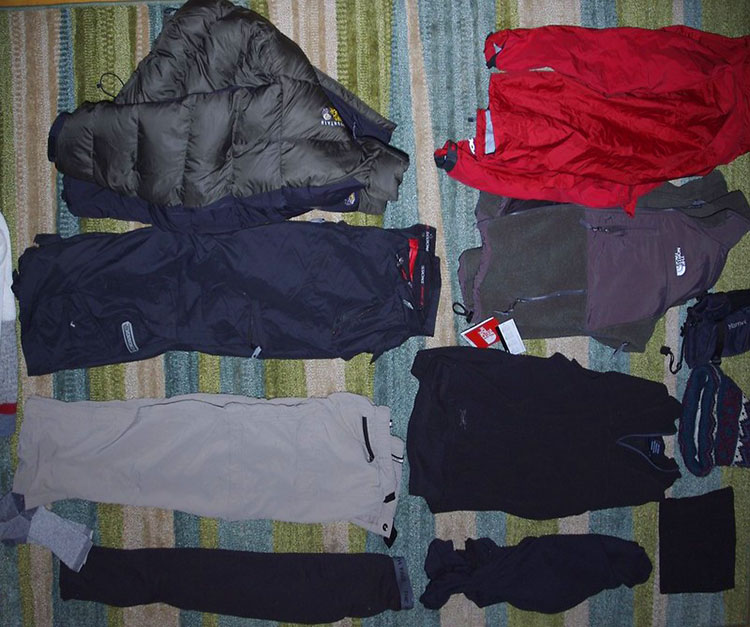
Since the trekking will go from 2860m to an altitude of 5380m. Thus it will be ideal to use layers of clothes as you can remove or add a layers of clothes depending on the need. While preparing your clothing list for Everest base camp trek, make sure you take enough and appropriate base layer clothes. The base layer will be used in the highest point of the trek as it will be the coldest destination. The next is the second layer of clothing that you will wear outside the base layer is the second layer. The insulation layer is available for both the upper and lower parts of the body. But the insulation layer for the upper part of the body should be enough for the trek.
Then comes the third and the outermost layer which is the most important of all the layers. This should be the thickest one and that protects from snow as well the extreme cold in the Base Camp. There are also chances of rain during several months of the year even at high altitudes. Hence for that, you should carry a waterproof down jacket.
Apart from these, the following should also be included in your clothing list for Everest base camp trek
- A pair of hiking trousers and hiking shorts.
- Lightweight nylon or polyester trekking shirts.
- A waterproof shell jacket and trousers will come in handy in case it rains.
- At least 6 pairs of underwear for women as well as men.
- At least 6 pairs of sports bra for women.
- A headwear to protect your head, face, and neck from the sunlight and cold.
- Inner and outer gloves to keep your hands warm in extreme cold.
A good pair of Everest hiking boots is a must for a comfortable trekking experience. Make sure you get hiking boots that has a strong grip and offer ankle support. This will provide wonderful trekking experience even in the most difficult trails. Also, make sure that your Everest hiking boots are neither too big nor too small. Heavy boots are not recommended as you will walk for a minimum of 9 days during the trek.
Mount Everest Gear List
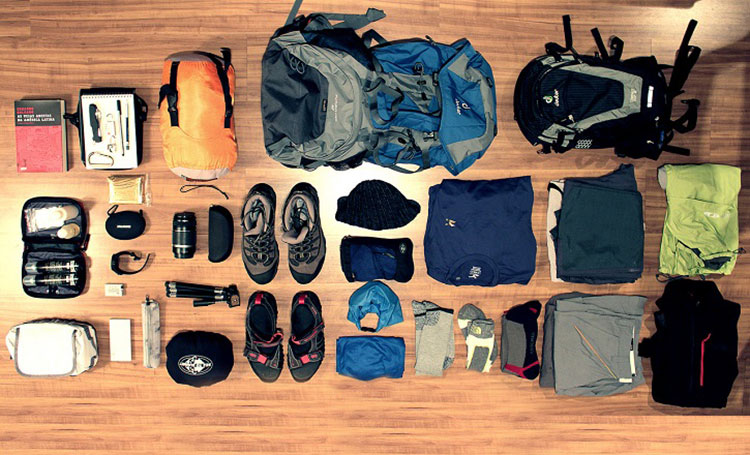
While preparing your Mount Everest gear list, you need to focus mainly on climbing equipment and camping gear.
Climbing Equipment includes items such as Ice axe, Crampons, Harness, Carabiners, Webbing, Perlon cord, Ascenders, Rappel device, etc. similarly, your camping gear list should include Backpack, Day pack, two sleeping bags, compression stuff sacks, sleeping pad, foam pad, water bottles, light weight steel thermal bottle, pee funnel for women, pack towel, trekking poles, swiss army knife, large mug, plastic bowls etc. these are the must haves in your mount Everest gear list.
Following are some of the major items that needs to be included in your Everest base camp trek packing list:
- Jacket synthetic or fleece
- Synthetic insulated pants
- Down suit
- Down insulated jacket w/ hood
- Down pants
- Waterproof breathable jacket & pants
- Wind shirts / light shell jacket
- One piece climbing shell (optional)
- Liner glove
- Windstopper fleece gloves
- Insulated climbing gloves
- Mittens with liners
- Bandanna
- Sun hat
- Wool or fleece hat
- Balaclava
- Face mask
- Sunglasses
- Glacier glasses
- Ski goggles
- Headlamp w/ spare bulb
- Spare batteries
You can add other items depending on your need while you plan for your Everest base camp trek or consult with the Nepalese trekking agencies.
Everest Base Camp Trek Difficulty
Many of the trekkers enquire on Everest base camp trek difficulty while planning their trekking in Nepal. Every year more than 40,000 people start their trek for the Everest Base Camp. But only a few succeed to complete the Everest base camp trek. The Everest Base Camp trek difficulty is rated as moderate difficultly. Over the years, people of all ages, shapes and sizes have completed the trek with minimum preparation. If you have the right determination you can easily conquer the trek.
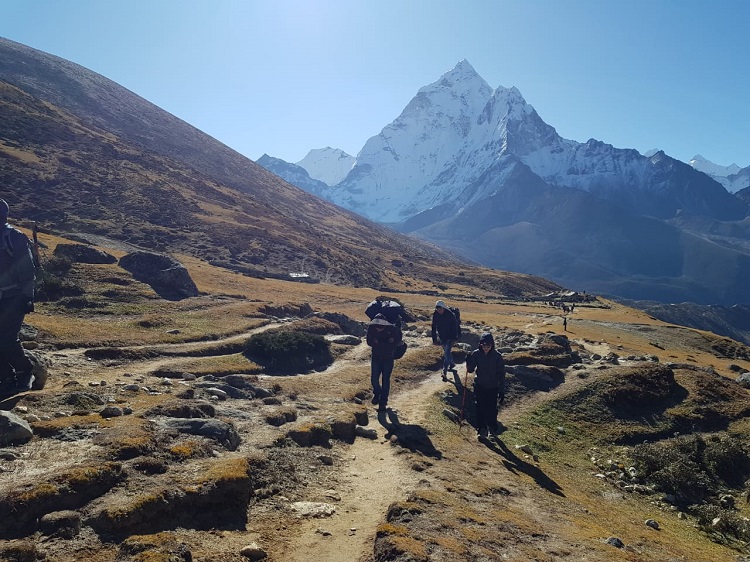
If you are wondering on how hard is Everest base camp trek, we are here to provide you the answer. Trekkers who have trekked to the Everest base camp claim that the Everest base camp trek does not require mountaineering skills or technical expertise. However, special attention should be given to proper acclimatization. Before starting your Everest base camp trek, it will be ideal to get professional medical advice and research altitude sickness to make yourself fully aware of the symptoms and treatments available.
To minimize your Everest base camp trek difficulty, make sure you pick the right itinerary. You need to allocate at least 3 days acclimatizing to the low levels of oxygen around 3,500m/ 11,500 feet around the town of Namche Bazaar. The Everest base Camp height is of 5,380 m (17,600 ft) on the south side of Everest in Nepal. All altitude related research suggests that you need acclimatize well at this critical point. If you fail to acclimatize well at this height you run a serious risk of getting the Everest base camp altitude sickness.
During your Everest base camp trek, you’ll encounter many hardships, problems, and pitfalls including the Everest base camp altitude sickness. The difficulty of getting to various points in the Everest Base Camp depends upon various factors. We get to hear about the Everest base camp trek deaths every year. These include the weather, your preparation, the amount of distance you cover during the trek, how steep the slopes are, how well you adjust to the altitude of these places and so on. No matter how hard is Everest base camp trek, the result is worth talking the risk.
Even though the Everest base camp trek is not so difficult physically, a bit of preparation would not do any harm. Your trek will be easier and efficient if you have high level of fitness. During the trek, you’ll be walking for at least 6 hours a day so, building up your strength before you leave is crucial. You can start your training roughly 6-8 weeks before your trek.
Your training plan can include the following:
- Several long hikes/walks a week
- Strength training at the gym focused especially on your legs
- Aerobic exercise to build up your endurance for those long days.
Every year we get to hear about Everest base camp trek death resulting from various factors. However, most of those incidents are associated with expedition and not trekking. In the year 2005, an avalanche claimed the lives of 19 climbers in camp II. The cause of most of the Everest base camp trek death is by the flood. The trail to base camp is safe from any avalanche. Every year approximately 3-5 people die each year on the EBC out of about 30,000 people. This is a death rate of about 0.01%, mainly due to the high altitude sickness.
With the right amount of physical and mental preparation, you can conquer the Everest base camp trek very easily.
Everest Base Camp Map
The Everest base camp trek is one of the longest trekking route among the most popular ones in Nepal. You can easily find the Everest base camp map, which is a standard map used by thousands of trekkers going for the Everest base camp trek. You can easily find this map online as well as in various stores especially in the Thamel area in Kathmandu. (include an image of the map)
In the Everest base camp map, you can easily see how high is Everest base camp. The Everest Base Camp trek distance is 130 km round trip starting from Lukla – the gateway to Everest. However, the outward 65 km to Everest Base Camp takes much longer as you need to consider acclimatization. Since all the trekkers use this route, it is heavily crowded in the trekking season. The route to the Everest base camp takes you through the best views of the varying landscapes, mountains, terrains and many ancient monasteries. There are about ten alternative routes to reach the Everest base camp. However, the most popular route is through Lukla. The trails from Lukla to the Everest base camp is ideal for walking.
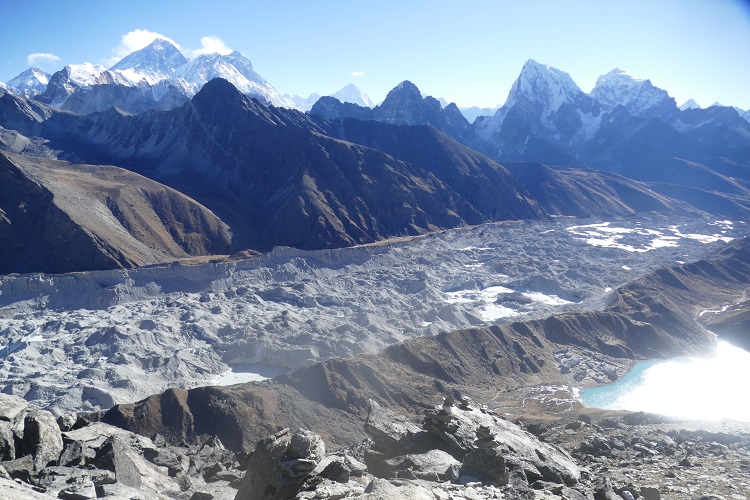
Your trek to the Everest base camp using the Lukla route starts from a flight from Tribhuwan international airport in Kathmandu to Lukla airport. Lukla is the hub for many trekkers to enjoy and relax for a day. According to Mount Everest route map, moving ahead from Lukla, you’ll reach Monjo where you can spend the night. The next day, the trek will move towards Namche Bajar.
Your itinerary will include a rest day in Namche Bazar. It is the place for acclimatization before moving to higher altitudes. Leaving Namche behind, you will rest at Tengboche and Dingboche for the next nights. From Dingboche, you will head towards Lobuche. And the next day, following the Mount Everest route map, you’ll reach the Everest base camp.
Then, the next destination will be Pheriche. From here, you’ll will hike to Kala Patthar from Gorakshep in the morning and arrive Pheriche the same day. Then comes the longest hike of your entire trek, i.e. trek from Pheriche to Khumjung village. After a long trek, you will have a good rest at Khumjung village. The next morning, you will get back to Monjo and to Lukla. From Lukla, you’ll return to Kathmandu.
Side Treks of Everest Base Camp
Here we will introduce you to the Side treks of Everest base camp:
Everest Three Pass Trek
The Everest Three Pass Trekking is one of the most adventurous trek in Everest region. The Everest Three Pass trek allows you to cross three prominent high altitude passes in the Everest Region. The trekkers cover the entire Everest region during their Everest three pass trek. Everest Three Pass trek can also be considered as the combination of the major treks of the Everest Region – Everest Base Camp trek, Everest Gokyo Lake trek, and of course, Everest High Pass Trek. And, the best thing about this trek is that it allows you to explore the entire Khumbu Valley in one single Everest High Pass Trek package.
The Everest three pass trek includes Renjo-La Pass, Cho La Pass and the Kongma La Pass. The Renjo-La Pass (5360m) is one of the three high passes of the Everest region. Located at 17,560 ft / 5,360 m, this is the lowest-altitude of the three passes (the other two being Kongma La and Cho La) and it’s the only pass that doesn’t require a glacier crossing. The Renjo-La Pass trek takes you to the Sherpa villages of Namche, Thame and Gokyo. As you reach the high pass of Renjo-La, you’ll get to enjoy the amazing views of the mountains along with the Gokyo Lake. This difficult trek treats you with panoramic views of Everest (8848m), Cho Oyu (8201m), Lhotse (8516m), Ama Dablam, Makalu (8481m), and many other snow-capped mountains of Khumbu region.
The Cho La Pass trek is ideal for the trekkers who are looking for thrilling and wild adventure. The most difficult part of the Cho La Pass trek is crossing the Cho La Pass border (5,420-m) itself. This beautiful trek goes through Gokyo Lake area and the Everest Base camp. The trail to the Cho La Pass goes through regions like Lukla, Namche Bazar, Tengboche and much of the Khumbu district. The trek to the Gokyo Cho La Pass also begins from Lukla. The trek moves towards Gokyo Lake after one day acclimatization in Namche Bazaar. Upon reaching the Gokyo Lake, you climb Gokyo Ri (5480 mtrs) from where you can enjoy stunning summit mountain scenery including Everest, Makalu, and Cho Oyo. The trek crosses Chola Pass ((5330 m) to reach Dzongla. After Dzongla you move towards Gorakshep and ascent to Kalapathar (5545m) from where you enjoy an impressive up-close view of Mt. Everest. . The best time for trek to the Cho La Pass is during autumn and spring. June, July and August are the low months to visit the Everest region as the trail remains slippery and muddy due to the monsoon.
The trek to the Gokyo Cho La Pass also begins from Lukla. The trek moves towards Gokyo Lake after one day acclimatization in Namche Bazaar. Upon reaching the Gokyo Lake, you climb Gokyo Ri (5480 mtrs) from where you can enjoy stunning summit mountain scenery including Everest, Makalu, and Cho Oyo. The trek crosses Chola Pass ((5330 m) to reach Dzongla. After Dzongla you move towards Gorakshep and ascent to Kalapathar (5545m) from where you enjoy an impressive up-close view of Mt. Everest.
You can choose to visit the Everest Base Camp on the next day of the trek. Your return route passes through Tyangboche Village where you can visit the very popular Tengboche Monastery. It takes about 17 days to complete the Everest three pass trek.
Kongma La Pass (5540m) is situated just above the Dingboche and south west of Mt. Everest, the highest mountain of the world. The journey to Kongma La Pass from Lukla follows the classic Everest trekking trail crossing famous places Namche bazaar-the gateway of Everest region, Tengboche, Dingboche to Kongma La pass. Also, Crossing the rugged high passes of Kongma La (5,545m), and Cho La (5,420m) with climbing of Chukung Ri (5,546m), Kalapathar (5,550m) and Gokyo Ri (5,357m) along with Everest Base Camp and Gokyo Valley makes this trek incomparable and unforgettable for trekkers. The Kongma La pass is enclosed by high Himalaya range which is better views of Himalaya including Mt Makalu, Nupche, Lhotse, Ama Dablam, Iceland Peak, Tabuche, Thamserku, Peak, and many more.
Spring and autumn are considered to be the best season for Kongma La Pass trek. The temperature is normal during the day time but during night time there will be freezing cold and sometimes weather is changeable and heavy snowy at that time.
Gokyo Ri Trek
The Everest Gokyo Ri Trek package takes you through a beautiful trek in the high Himalayas of the Everest region. This trek with moderate difficulty is suitable for both experienced trekkers as well as beginners. The summit of Gokyo Ri offers you the panoramic mountain views, including four 8,000m peaks — Mt. Everest, Lhotse, Cho Oyu, and Makalu.
The Everest Gokyo Ri Trek is also known as Trekking peak as it allows the trekkers to reach the summit without climbing gears and peak permits. There are a total of 19 lakes in the Gokyo region and all of them are formed with a freshwater system, collectively known as the Everest gokyo lakes. The trek starting from Lukla heads towards Phagding, Namche Bazaar, dole Machhermo, and Gokyo Lake, which follow naturally stone step trails same trails as used by locals Sherpa and “Yak” caravan supply the stuff to Machhermo and Gokyo. The Everest Gokyo Ri trek also leads through the Gokyo lake, Gokyo Ro and Machermo Base Camp. Everest Gokyo Ri Trek leads to biggest glacier in the himalayas, where several glacial lakes formed by the melting of glacier are found. These glacier are filled with crystal clear water. Apart from this, you’ll also come across a Sherpa Museum where you can experience Sherpa culture and tradition.
In addition, during the Everest Gokyo Lake Trek, you get to enjoy the diversified flora and fauna along with colorful Rhododendron and Bamboo forests, amazing landscapes and warm hospitality of the local Sherpas with their culture and traditions.
Sherpa Village Lodge Trek
If you want to experience the Sherpa lifestyle and culture, the Sherpa Village Lodge Trek is best for you. Sherpas, a tribe of people indigenous to Nepal, have been living in the hills across Nepal, and especially in the Khumbu region for decades. The Sherpas are considered as ideal expedition guides as their bodies have naturally evolved to survive the low oxygen density in air since they’ve been living in such a high altitude for such a long time.
Sherpa village trek is named after two most popular villages of the Khumbu area- Tengboche (3867m)
and Khumjung (3780m) located within Sagarmatha National Park, a world heritage site. The Tengboche village is a religious center for all Sherpa community of the Everest region. Here you can observe the Himalayan culture along with the traditional lifestyle of the Sherpa people. In this village you can visit Tengboche Monastery and Sherpa Culture Museum. During your trip to the Sherpa village, you can see that the Sherpa House, Sherpa Clothing, Sherpa Food, and so on are all focused towards keeping the Sherpa people warm and healthy in the extreme climates of the mountains. One of the examples of Sherpa Village is Kumjung Sherpa Village which lies at an altitude of 3790 m.
The Sherpa Village Lodge Trek package includes a 10 days long trek. You’ll be covering Sherpa villages like Jorsalle, Phakding, Monjo, and so on during this trek. During the trek, you can also enjoy the wonderful views of peaks such as Everest, Cho Oyu, Nuptse, Ama Dablam, Lhotse, and so on. The reason behind this trek being named as the Sherpa Village Lodge Trek is you’ll get spend your night in the comfortable lodges.
Instant Everest Lodge Trek
The Instant Everest Lodge Trek package is an 8-days trek designed to explore the Khumbu region. This trek starts with a flight from Kathmandu to Lukla airport. Upon reaching Lukla, the trek moves through Dudh Kosi (River of Milk) Valley to reach Namche Bazaar, the capital of the region. Namche Bazar is mostly used by the trekkers as a stop for acclimatization. You’ll be spending most of the time acclimatizing and visiting the Park Museum and Sherpa homes.
The next day, we’ll move from Namche Bazar towards Thyangboche. Thenchboche, is the perfect destination to get the views of Nuptse, Lhotse, Ama Dablam, Mt. Thamserku and Everest are truly fantastic. The village of Thyangboche is famous for Tengboche Monastery which is also known as Thyangboche or Dawa Choling Gompa. It is one of the largest monasteries in the Everest region.
Walking through the picturesque Sherpa village and visiting the sacred Tengboche Monastery is the main attraction of the Instant Everest Lodge Trek. The best time for Thyangboche Monastery Trek is spring and autumn season. During the spring, the weather is stable and also the hills are well covered by the variety of colorful rhododendron flowers which make this place even more beautiful. You can also visit this region during autumn season when the temperature is moderate with stable weather conditions. Also, every October, Tengboche Monastery hosts the colorful Mani Rimdu festival.
Ultimate Everest Trek
The Ultimate Everest Trek combines the Everest Base Camp trek and Gokyo Lake trek. Everest Base Camp trekking allows you to enjoy the natural beauty to religious and cultural heritages. During the Everest base camp trek, you get to explore the lifestyle of the locals living in the region, and understand their way of life. If you take a guide with you, you can also communicate with them, and get amazed by their numerous stories related to Mount Everest, especially Everest Base Camp tour.
Tengboche village is an important part of the Everest base camp trek. This village is known mainly because of the Dawa Chholing Gompa, which is the most crucial Buddhist pilgrimage site in the region. Passing through the Tengboche village, you’ll finally reach Everest Base Camp. Kala Patthar is another major attraction of the Everest base camp trek. This destination offer the best views of the peaks in the region, and especially that of Everest.
This Everest base camp trek can be enjoyed to the fullest if you add the Gokyo Lake Trekking. This combination known as the ultimate Everest trek is a 17 days long journey. The places covered in the Ultimate Everest trek package are Khunde, Dole, Machhermo, Dragnak, and so on. During the trek, you will also get to cross Cho La, which is a high altitude mountain pass situated at an elevation of 5420 m.
Gokyo Lake trek, also known as Gokyo Ri trek, takes you to the top of this mini mountain called Gokyo Ri. Located at a height of 5340 m, it offers the most amazing views of the peaks in the Everest Region. Gokyo Lakes is another major attraction of Gokyo Valley trek. Altogether, there are 19 lakes, and they are all oligotrophic, which means that not even a single creature, including microorganisms, harbor around the lake.
Kala Patthar Trek
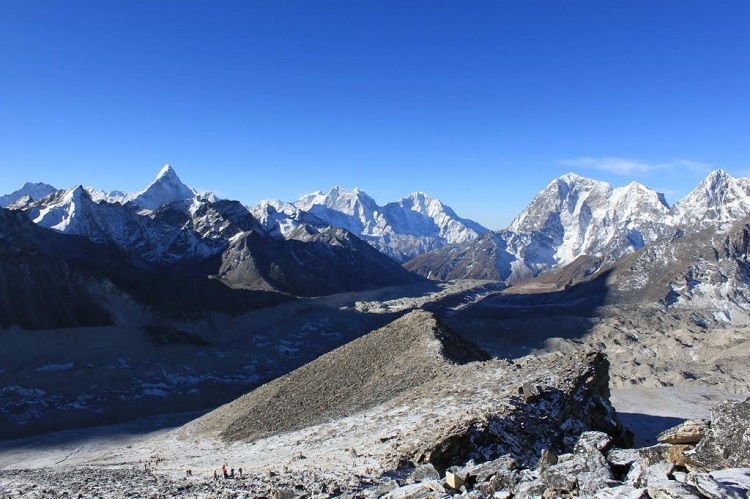
Kala Patthar, which means a black rock in English, stands at an altitude of 5,644m above sea level. The trip to Kala Patthar is preferred by almost every trekkers as it provides the best view of Everest from this point. The trip to Kala Patthar is about 3-5 hrs round trip from Gorakshep. Kala Patthar is considered to be the best point in the Everest Base Camp trek.
The name Kala Patthar is derived from the coloration of the rock that make up its peak – a dark black that stands in stark contrast to the snow-capped peaks it surveys. Trip to Kala Patthar has become very popular these days as you can get the beautiful view of the peak of Mount Everest from the top. You cannot get this view even from the Everest Base Camp.
Gorak Shep provides the best “launching pad” for an ascent of Kala Patthar. You can also get the best view of Everest from Gorak Shep. You can enjoy the glorious view of Mount Amadablam, Makalu, Cholatse, Nupse, Pumori and many other great peaks Kala Patthar. During your Kala Patthar trek, you’ll experience wildlife, nature and culture of different places on the route. So, on this trek, do not miss the view of Everest from Gorak Shep.
Everest Kala Patthar Trek package is of about 16 days. The best time to visit Everest base camp is autumn (Sep. to Dec.) and spring (March to May). Winter (Dec, Jan, and Feb) is also good for Everest Base Camp Trek. Summer and monsoon (June and July) will be rainy but less crowded where you can enjoy best of the natural beauty of this place.
Jiri To Lukla
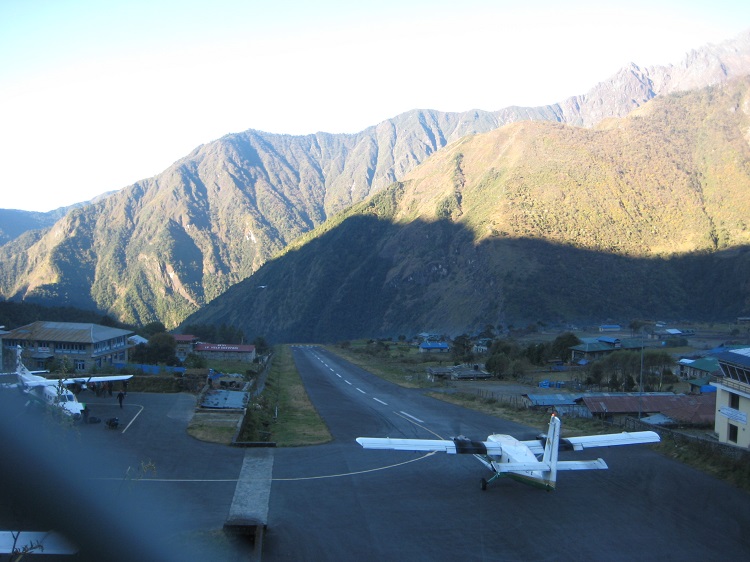
Another route for the Everest base camp apart from Lukla is Jiri. Instead of taking the short flight from Kathmandu to Lukla, you can take the Jiri route that starts with a 7-hour long bus ride from Jiri to Lukla where the trek begins. If you wish to follow the footsteps of Tenzing and Hillary, you can start your Everest base camp trek from Jiri. Everest Base Camp trek via Jiri treats you with an unbeatable combination of natural beauty and cultural splendor. Just like the Lukla route, you can enjoy beautiful mountains views, terraces and Himalayan streams and water falls as the trail passes through villages and landscapes covered by rhododendron, magnolia and giant forests.
Highlights of the trek include the first week spent chiefly in the Solu Khumbu region among pristine terraced farmlands, forests and the beautiful Dudh Koshi River. Most of the Sherpa people live in this region so expect to encounter the friendly hospitality of the locals while you learn about their culture and customs as you slowly acclimatize to the high altitude. Some of the major attractions of Everest base camp trek via Jiri includes trekking through the Solu area and traversing the great Lamjura pass filled with excellent views of the high, snow-capped peaks, the spectacular scenery of the Himalayan ranges, the prevalent Himalayan culture, the pristine forest of rhododendron and pass through traditional rural farming villages. Everest Base Camp trek via Jiri include all the highlights of the Everest National Park including Namche Bazaar, Khumbu’s Sherpa capital, an extraordinary viewpoint of Kalapatthar (5545m/18,187ft) and ever exciting Everest Base Camp.
Makalu Base Camp To Everest
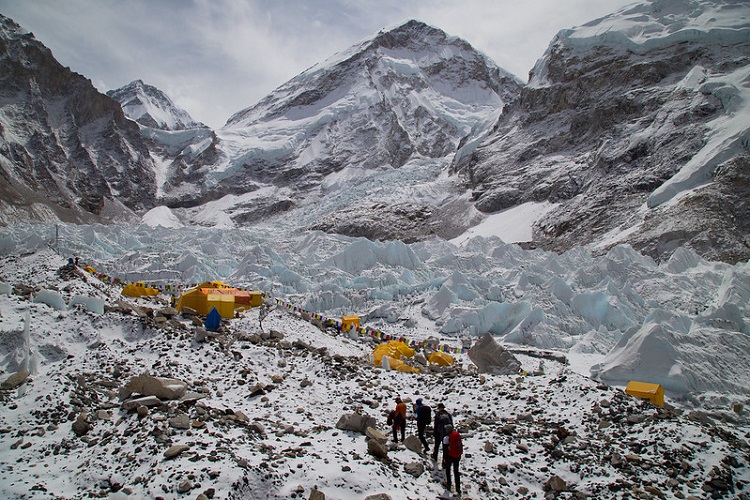
The trek from Makalu base camp to Everest will take you to the least explored areas of Nepal. During this trek, you’ll walk through three passes i.e. Sherpani Pass, West Coland Amphu Laptsa. Heading towards Tumlingtar, you’ll come across steamy lowlands near the Arun River over the Shipton La and into the remote and beautiful Barun river valley and finally arrive the Makalu Base Camp. From here we cross Sherpani Pass over to Baruntse Base Camp, then cross West Col to Panch Pokhari followed by the Amphu Laptsa into the Everest.
Makalu Base Camp to Everest trek crosses high Himalaya glacier and altitude of over 5700m with extreme temperatures of -10 to -20 degree. So, it is crucial to follow expedition style camping trekking facilities with highly experience Sherpa and staffs.
During the trek, you’ll be able to experience large diversity of ecosystems, cultures and villages of Rai and Sherpa indigenous community. Makalu base camp trekking is culturally and environmentally diverse region along with unsurpassed beauty, towering Himalayan peaks, biological diversity. Fascinating and challenging trek to the base camp of Makalu (8462m) passes through the Makalu Barun National Park and ends at the base camp, the best spot for viewing the fantastic mountains like Everest, Makalu and Lhotse. The trail provides magnificent panorama of Makalu south face, Everest, Lhotse, Kanchenjunga and Chamlang. The area is not used by the foreigners because of its remoteness, wilderness, pristine forests and alpine meadows in Nepal. Since this trek is bit difficult, previous mountaineering experience is required to safely complete this trek.
Everest Expedition
If you are looking for a longer trek with more challenges, you can go for the Everest extension. Every year thousands of tourists from all over the world visit Nepal especially for the Everest expedition. The challenges faced during the Everest expedition is made worth by the view from the top of Everest, beautiful landscape that varies through the trek, flora and fauna, rivers and Georges, cultural heritage sites and of course, the picture perfect majestic Himalayas.
As the name suggests, the Everest expedition is the extension of the Everest base camp trek. It has been a dream of many mountaineers to conquer the Everest. But, the difficulty faced in this expedition cannot be ignored as many of the summiteers who leave for the Everest climb never return back.
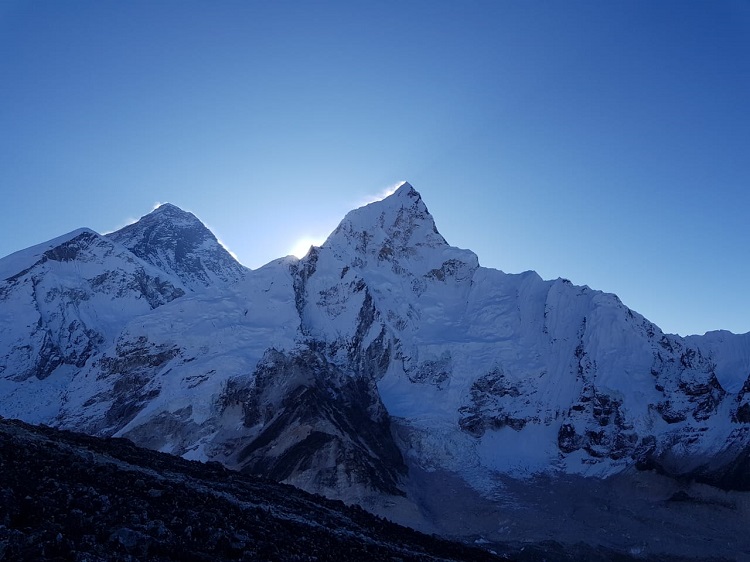
Mount Everest Expedition was led my British expedition John Hunt. In 1921, Lt. Colonel Charles Howard-Bury led the first expedition on Everest. Since 1953, more than a thousand people have climbed Everest and among them Apa Sherpa has summited twenty times. The most commonly used route up the mountain is the South-east ridge. Mount Everest expedition is also possible to summit from Tibetan side. Mount Everest expedition can be climbed from the both southern side of Nepal and northern side of Tibet as well. The Nepal tourism board provides the Expedition permit, Expedition royalty and other rule and regulation through easy way to reach climbers destination. People are even more excited by the Mount Everest Summit photos brought by the mountaineers.
The trail that leads towards the Everest is full of challenges. Few of the areas of the region are so dangerous that it possesses life threatening risks. For instance, the Khumbu Icefall is considered to be one of the most dangerous stages of the South Col route to Everest’s summit. The Khumbu Icefall is located at the head of the Khumbu Glacier and the foot of the Western Cwm at an altitude of 5,486 metres (17,999 ft) on the Nepali slopes of Mount Everest.
The beautiful Khumbu Icefall is an ever-changing and fast-moving river of ice that challenges and inspires mountaineers from all over the world. The icefall is situated at the lower end of the Western Cwm, the start of the Khumbu Glacier, one of the highest and largest glaciers in Nepal running approximately 15 km and beginning high on the Lhotse Face at around 7500 meters (24606ft).
Another interesting yet very dangerous part of the climbing Mount Everest is the Everest Rainbow Valley. It can also be seen in the Mount Everest summit photos. This is a particular section in the Everest trail is located on the cliff of Mount Everest. This region is full of dead bodies of climbers who were not able to make it back, or make it to the top. This region is named as the Mount Everest Rainbow Valley as it is full of dead bodies with different colored jackets. Thousands of dead bodies lies untouched in the Mount Everest Rainbow Valley as it is very difficult to bring back the dead bodies. Hundreds of dead bodies on Everest with different colored jackets make this area look like a rainbow. The meaning of the name “Mount Everest Rainbow Valley” surely does make you think twice about your Everest expedition trip.
Climbing Mount Everest is undoubtedly an unforgettable lifetime opportunity. Nevertheless, these expeditions encounter many hindrances such as high altitude, severe weather conditions and avalanches. This is why, the trekkers going for the Everest expedition need to be properly trained. You need to be physically and mentally fit for the 8848m-foot climb to Everest’s summit. Depending on your current level of fitness, you need to train for several months before you start your ascent. A climber must build his/her cardiovascular strength along with muscular strength; oxygen level drops by 60-70 percent from sea level. Also make sure you can carry big bag packs to top, as you will be carrying cylinder of oxygen and large bag packs along with you. One must acclimatize with weather conditions and be prepared for rock falls, avalanches. Learning rescue techniques would be added advantages.
If you are wondering on how long it takes to climb Mount Everest, let us inform you that it takes nearly two months (60-65 days) to climb Mount Everest. Climbing the Mount Everest requires this much time because the weather, temperature and climbing conditions at Everest are demanding. Also you need to acclimatize a lot before you could reach the summit successfully and get back down. Upon reaching the top, the view from the top of Everest will make the entire trek worth the effort.
Everest Trail Walker P. Ltd
Everest Trail Walker is a guide owned adventure trekking and tour agency based in Kathmandu, Nepal. Managed by a group of experienced trekking guides with more than a decade in trekking, travel and tour service in the Himalayan of Nepal, Tibet, Bhutan and Sikkim. We are offering various tours and treks plans for groups and individuals in Nepal including the Everest base camp trek, Annapurna base camp, Langtang, Annapurna circuit, Kanchenajunga, Dolpo, as well as other Asian regional destinations like Tibet, Bhutan, Sikkim, Leh & Ladakh in India.
Our goal is to provide adventure trekkers a complete choice of treks, tours, raft trips, Safari and climbing with high quality and safety standard. All our treks are operated with a strong and experienced Sherpa support team. All our trips are operated in an environmentally safe and locally beneficial way.
Why Choose Us?
Since establishment, Everest Trail Walker has been providing the tourists with the largest choice of adventure treks and tours activities. By providing a wide range of excursions for our clients, we are able to design custom-tailored made itineraries to suit every ones needs, based on a unique and competitive self-sufficient tools. We believe in providing quality and personal attentive service to guarantee our clients full satisfaction and comfort, without subjecting our clients to extra costs hidden in the form of local payments. The prices we offer are all-inclusive unless otherwise noted.
Our expedition guides/leaders are fully trained and have years of experience in Nepal, Tibet and Bhutan’s remotest outdoors. You may have specific requirements, or wish to combine different itineraries to design your own adventure, we can help you to design your own personal safari and advise you on the feasibility of your request.
Do contact us if you are planning a trek to the Everest Base Camp. All our Everest Expedition climbing Sherpa have extensive knowledge of trails, wilderness medical training and they are competent to deal with the normal medical issues. We have Oxygen and comprehensive medical kits along with a Gamow bag available as a safety back up.
We also motivate all the climbers to carry personal micro medical kits with them. We use most recent, tested TOP OUT mask and oxygen regulator and 4 litre Poisk oxygen bottles. Good weather is essential on all Everest expeditions and to ensure the safety of all our climbers and supporting crew. We use a professional and reliable weather forecast service for the whole expedition period with regular info and updates until the ultimate summit push and safe return to base camp.

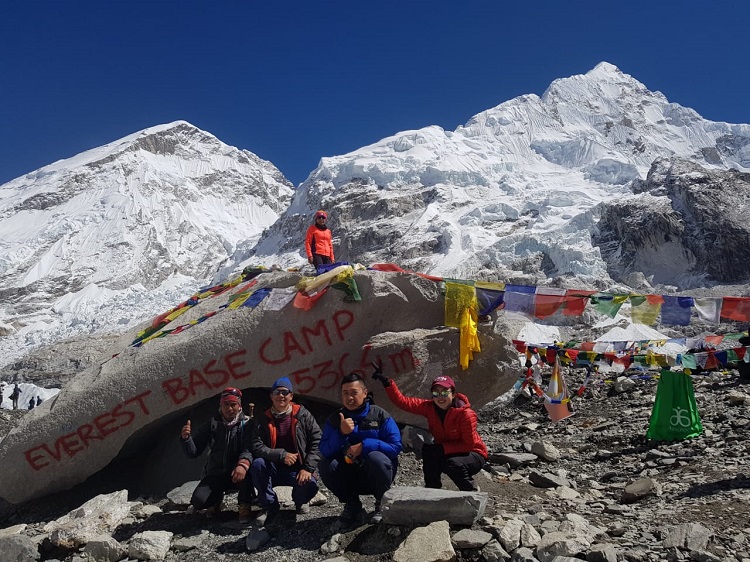
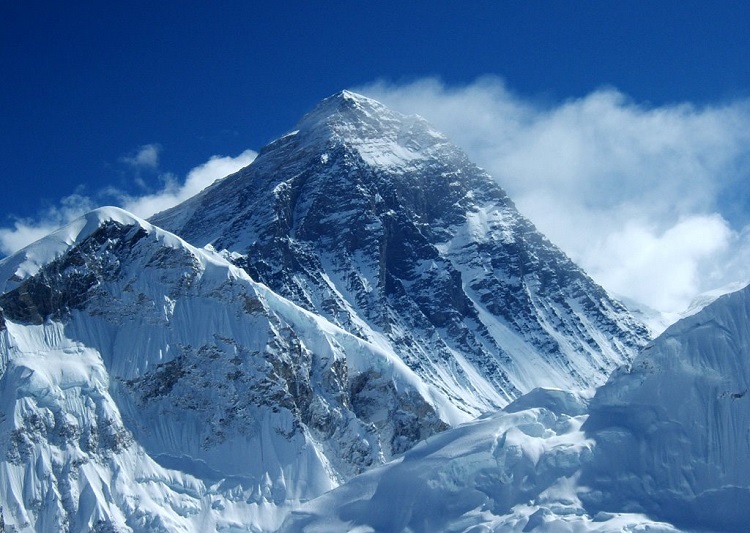
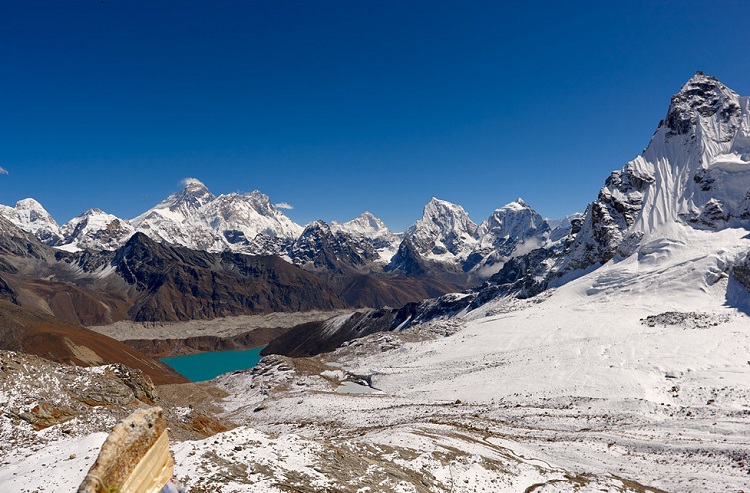
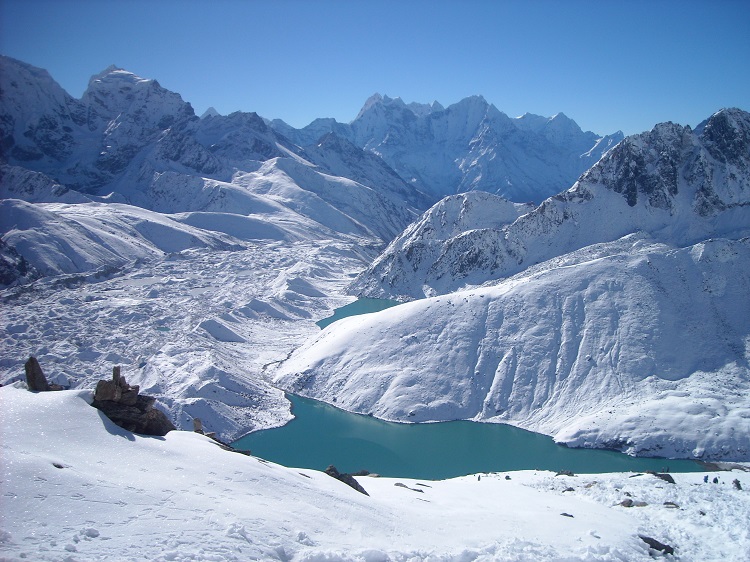
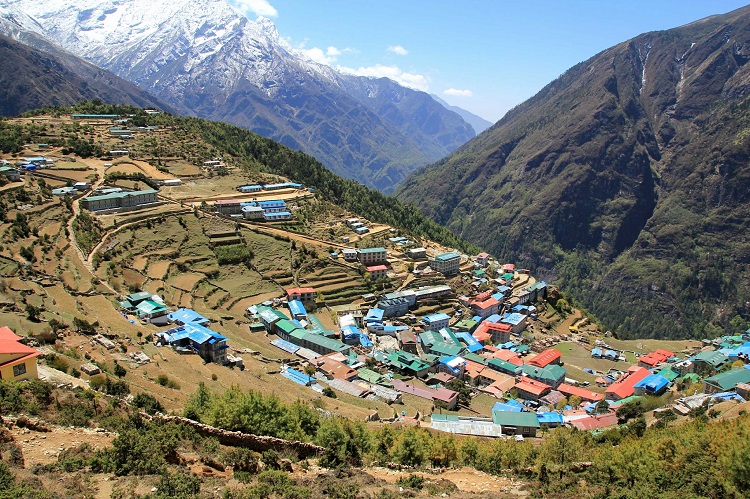
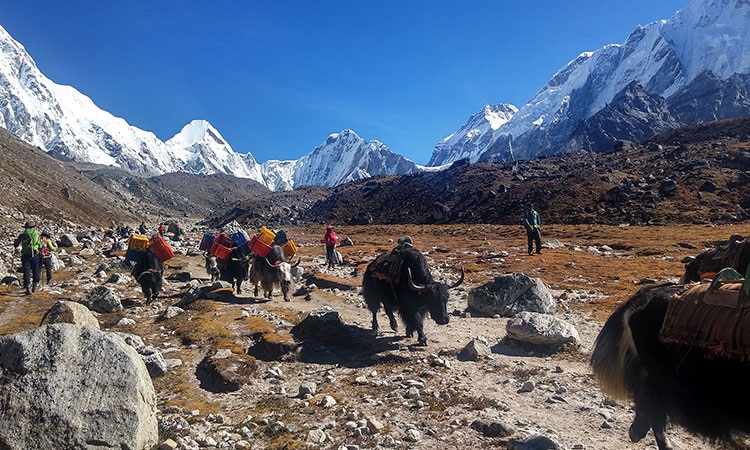
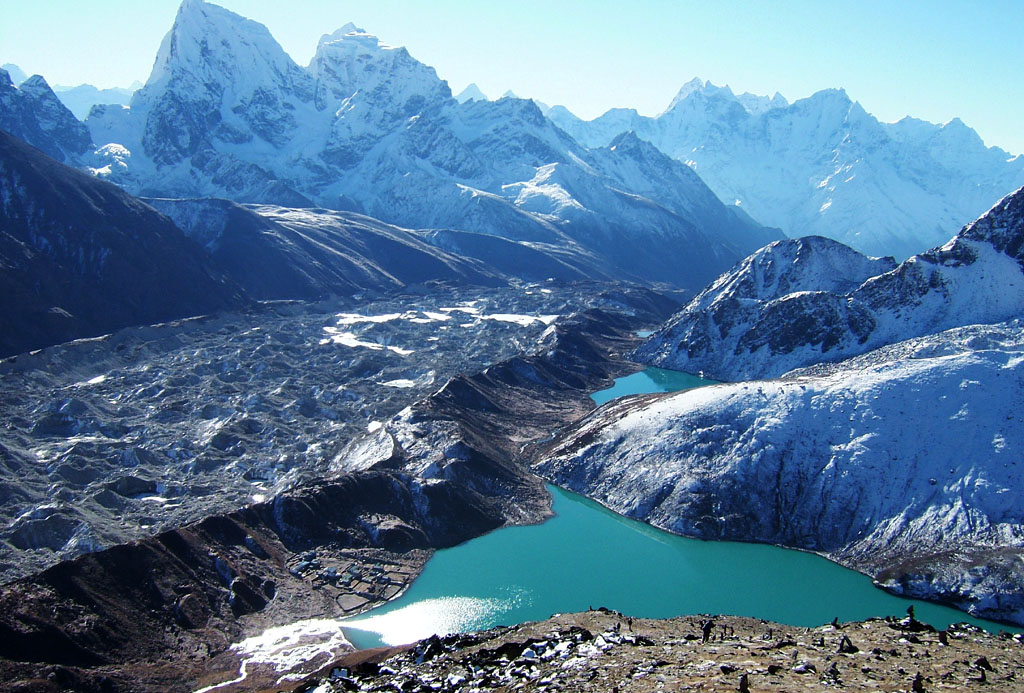
Very interesting subject , thanks for posting.